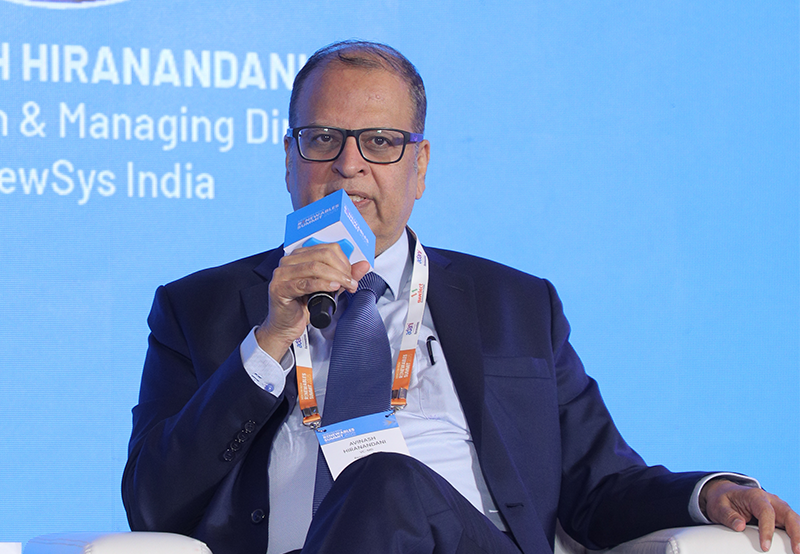Solar Cell Demand Can be Met with a Short Deadline Extension if Needed: Interview
The government has created the demand for DCR modules, and the industry is playing catch-up
August 18, 2025
Follow Mercom India on WhatsApp for exclusive updates on clean energy news and insights
In an interview on the sidelines of the Mercom India Renewables Summit 2025 held in New Delhi on July 24 and 25, 2025, Avinash Hiranandani, Vice Chairman and Managing Director at RenewSys, shared his insights on India’s solar cell and module, and components manufacturing. He also gave an overview of his company’s products and plans for expansion.
India has set a goal of 500 GW of non-fossil fuel energy capacity by 2030. How do you see RenewSys contributing to this goal?
RenewSys has been in the market for more than 10 years. We started off by making encapsulants and backsheets. We have supplied close to 30 GW to the Indian and overseas markets. So, we are an important part of the solar manufacturing sector in India.
We have also been supplying cells and modules, and today we have 5.5 GW module manufacturing capacity ready to start by September. We are also starting our TOPCon cell manufacturing facility. RenewSys has always been supplying high-quality products to the Indian market, and we will continue doing so to help India achieve its 2030 targets.
How do you view the current solar module and cell manufacturing landscape in India?
Today, solar module capacity as per the Approved List of Models and Manufacturers is about 90 GW plus. Solar cell capacity is close to 25 GW in the market and growing very fast. Many small players are also in the market, catering to small capacities. Large-scale projects can be executed much faster if these players become bigger.
What are RenewSys’s plans for expanding the capacities of encapsulants and other components?
Currently, we have 10 GW and are planning to add another 10 GW. With a pipeline of another 10 GW, we will reach 30 GW. We will be adding 20 GW more to reach 50 GW of encapsulant capacity. We are also making transparent back sheets. Transparent backsheets also play a very important role in the market, and they are ready to be supplied.
What is domestic demand like now?
The domestic demand for modules is 90 GW. Some of the components still come from free trade countries and from China. But many players have now realized that sometimes the containers take a lot of time to arrive. The products may also get spoiled in transit. RenewSys makes encapsulants every day. So, the products are fresh.
Are there any quality standards that have been set up for encapsulants and other components in India?
There are IEC standards, and RenewSys has its own standards. We conduct reliability tests on our products. We only sell those products that we use ourselves. That is how we have maintained our leadership position in the Indian market. However, there are no government standards for components like aluminum frames and junction boxes.
Solar developers have been complaining about the unavailability of modules compliant with domestic content requirements. How do you see this situation?
The government has created the demand for DCR modules, and the industry is playing catch-up. Something must start first. If there is no demand, there is no production. There will be periods when you cannot have both demand and supply equally.
When ALMM was introduced, there was hardly any capacity module capacity available. At that time, developers were saying there was not enough capacity available, but now they are saying there is overcapacity.
So, when policies are introduced, demand will follow. You cannot set up capital expenditure-intensive cell lines in the hope that the policy will follow.
With ALMM for cells also coming into effect from June 2026, do you think the Indian manufacturing industry will be able to cope with the demand?
The government is already taking data from manufacturers. It will probably decide whether June 2026 should be the date or whether it should be postponed by three months or six months. That is a call the government will take. Probably with a three to six-month postponement, I think the capacities will come up.
The government is also focusing on backward integration in the solar ecosystem. What are RenewSys’ plans for this?
There is limited support for other products, such as junction boxes, aluminum frames, and encapsulants. The government is in regular contact with us to determine what support can be provided. Then you’ll see the ancillary industry booming, just like solar manufacturing boomed.
India doesn’t have a clear target beyond 2030 for renewable energy. What do you think India’s capacity should be by 2040?
India should add 250 GW of manufacturing right across the solar sector every year. So, there is still significant scope for growth. Solar is not overcrowded. In the long run, there is sufficient space for everyone to participate and for larger players to also enter and develop the solar value chain in the country.
(Note: Sections of the interview have been paraphrased for better reading. Check out the video for a full chat)
